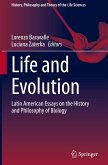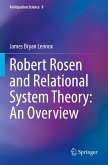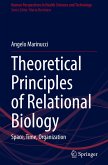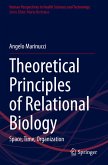Scaffolding: Selected Contributions of James R. Griesemer to History, Philosophy, and Biology
Herausgegeben:Ankeny, Rachel A.; Dietrich, Michael R.; Leonelli, Sabina
Scaffolding: Selected Contributions of James R. Griesemer to History, Philosophy, and Biology
Herausgegeben:Ankeny, Rachel A.; Dietrich, Michael R.; Leonelli, Sabina
- Gebundenes Buch
- Merkliste
- Auf die Merkliste
- Bewerten Bewerten
- Teilen
- Produkt teilen
- Produkterinnerung
- Produkterinnerung
This book brings together some of Griesemer's most significant contributions for the first time, making it widely accessible in a single collection. Throughout his career James Griesemer has created an intellectual scaffold for major advances in the history and philosophy of biology. His analyses of boundary objects, units of selection, reproducers, models, and scaffolds have served and continue to serve as sites of innovation for philosophers, historians, and biologists. Griesemer's oeuvre does not form a mere collection of important essays on disparate and disconnected topics. His works are…mehr
Andere Kunden interessierten sich auch für
![Life and Evolution Life and Evolution]() Life and Evolution76,99 €
Life and Evolution76,99 €![Life and Evolution Life and Evolution]() Life and Evolution76,99 €
Life and Evolution76,99 €![Robert Rosen and Relational System Theory: An Overview Robert Rosen and Relational System Theory: An Overview]() James Bryan LennoxRobert Rosen and Relational System Theory: An Overview83,99 €
James Bryan LennoxRobert Rosen and Relational System Theory: An Overview83,99 €![Robert Rosen and Relational System Theory: An Overview Robert Rosen and Relational System Theory: An Overview]() James Bryan LennoxRobert Rosen and Relational System Theory: An Overview83,99 €
James Bryan LennoxRobert Rosen and Relational System Theory: An Overview83,99 €![Canguilhem and Continental Philosophy of Biology Canguilhem and Continental Philosophy of Biology]() Canguilhem and Continental Philosophy of Biology91,99 €
Canguilhem and Continental Philosophy of Biology91,99 €![Theoretical Principles of Relational Biology Theoretical Principles of Relational Biology]() Angelo MarinucciTheoretical Principles of Relational Biology83,99 €
Angelo MarinucciTheoretical Principles of Relational Biology83,99 €![Theoretical Principles of Relational Biology Theoretical Principles of Relational Biology]() Angelo MarinucciTheoretical Principles of Relational Biology83,99 €
Angelo MarinucciTheoretical Principles of Relational Biology83,99 €-
-
-
This book brings together some of Griesemer's most significant contributions for the first time, making it widely accessible in a single collection. Throughout his career James Griesemer has created an intellectual scaffold for major advances in the history and philosophy of biology. His analyses of boundary objects, units of selection, reproducers, models, and scaffolds have served and continue to serve as sites of innovation for philosophers, historians, and biologists. Griesemer's oeuvre does not form a mere collection of important essays on disparate and disconnected topics. His works are best understood as units in a large philosophical puzzle, amounting to an overarching vision of how humans understand life and use that understanding for intervention, which in turn is grounded in a highly sophisticated historical and scientific understanding of the research practices in question. With edits, comments, and an in-depth introduction, this book is of great interest to historians and philosophers of biology as well as science in general.
Produktdetails
- Produktdetails
- Verlag: Springer / Springer Nature Switzerland / Springer, Berlin
- Artikelnr. des Verlages: 978-3-031-84608-3
- Seitenzahl: 420
- Erscheinungstermin: 28. Juni 2025
- Englisch
- Abmessung: 241mm x 160mm x 29mm
- Gewicht: 736g
- ISBN-13: 9783031846083
- ISBN-10: 3031846087
- Artikelnr.: 72736917
- Herstellerkennzeichnung
- Springer-Verlag GmbH
- Tiergartenstr. 17
- 69121 Heidelberg
- ProductSafety@springernature.com
- Verlag: Springer / Springer Nature Switzerland / Springer, Berlin
- Artikelnr. des Verlages: 978-3-031-84608-3
- Seitenzahl: 420
- Erscheinungstermin: 28. Juni 2025
- Englisch
- Abmessung: 241mm x 160mm x 29mm
- Gewicht: 736g
- ISBN-13: 9783031846083
- ISBN-10: 3031846087
- Artikelnr.: 72736917
- Herstellerkennzeichnung
- Springer-Verlag GmbH
- Tiergartenstr. 17
- 69121 Heidelberg
- ProductSafety@springernature.com
Rachel A. Ankeny is Professor and Chair in the Philosophy Group at Wageningen University, The Netherlands, and Affiliate Professor in History and Philosophy, School of Humanities at the University of Adelaide, Australia. Her main research interests are in philosophy and history of biological and biomedical sciences, bioethics, and food ethics. She is currently the Editor-in-Chief for Studies in History and Philosophy of Science, and was co-founder of the Society of Philosophy of Science in Practice (SPSP) which seeks to promote greater engagement of philosophers of science with scientific practices through building a collaborative philosophical community open to scholars and practitioners employing diverse disciplinary and methodological approaches. Michael R. Dietrich is a Professor in the History and Philosophy of Science Department at the University of Pittsburgh. His research focuses on the history and philosophy of modern biology, especially scientific controversies. He has co-edited several books, including most recently, Nature Remade: Engineering Life from Gene Drives to Gaia (University of Chicago Press, 2021). He is also the series editor for the Historiography of Science major reference work series with Springer. Sabina Leonelli is professor of philosophy and history of science and technology at the Technical University of Munich, where she co-directs the Ethical Data Initiative and the Public Science Lab. Until 2024 she was the Director of the Exeter Centre for the Study of the Life Sciences at the University of Exeter, where she now holds an honorary professorship. Her research investigates the roles played by technology, models, data and collaborative methods within the life sciences and public health. She aims to contribute to an understanding of knowledge production that can support equitable, responsible, engaged, and sustainable research practices.
1: Introduction: Scaffolds for the Study of Science (Rachel A. Ankeny, Michael R. Dietrich, and Sabina Leonelli).- 2: Reflection on Taking a Class with Feyerabend (James R. Griesemer).- 3: Introduction to "Laboratory Models, Causal Explanation and Group Selection" (Michael J. Wade).- 4: Laboratory Models, Causal Explanation and Group Selection (James R. Griesemer and Michael J. Wade).- 5: Introduction to "Picturing Weismannism: A Case Study of Conceptual Evolution" (Rachel A. Ankeny, James R. Griesemer, and William C. Wimsatt).- 6: Picturing Weismannism: A Case Study of Conceptual Evolution (James R. Griesemer and William C. Wimsatt).- 7: Introduction to "Institutional Ecology, 'Translations,' and Boundary Objects: Amateurs and Professionals in Berkeley's Museum of Vertebrate Zoology, 1907-1939" (Geoffrey C. Bowker).- 8: Institutional Ecology, 'Translations,' and Boundary Objects: Amateurs and Professionals in Berkeley's Museum of Vertebrate Zoology, 1907-1939 (Susan Leigh Star and James R. Griesemer).- 9: Introduction to "Modelling in the Museum: On the Role of Remnant Models in the Work of Joseph Grinnell" (Lynn Nyhart).- 10: Modelling in the Museum: On the Role of Remnant Models in the Work of Joseph Grinnell (James R. Griesemer).- 11: Introduction to "Material Models in Biology" (Lisa Gannett).- 12: Material Models in Biology (James R. Griesemer).- 13: Introduction to "Collaboration in the Museum of Vertebrate Zoology" (Elihu M. Gerson).- 14: Collaboration in the Museum of Vertebrate Zoology (James R. Griesemer and Elihu M. Gerson).- 15: Introduction to "Space <-> Time: Temporality and Attention in Iconographies of the Living" (Vivette García-Deister).- 16: Space <-> Time: Temporality and Attention in Iconographies of the Living (James R. Griesemer).- 17: Introduction to "Transforming Objects into Data: How Minute Technicalities of Recording 'Species Location' Entrench a Basic Challenge for Biodiversity" (Beckett Sterner).- 18: Transforming Objects into Data: How Minute Technicalities of Recording 'Species Location' Entrench a Basic Challenge for Biodiversity (Ayelet Shavit and James R. Griesemer).- 19: Introduction to "Formalization and the Meaning of 'Theory' in the Inexact Biological Science" (Matt Haber).- 20: Formalization and the Meaning of 'Theory' in the Inexact Biological Science (James R. Griesemer).- 21: Introduction to "What Salamander Biologists Have Taught Us About Evo-Devo" (Alan Love).- 22: What Salamander Biologists Have Taught Us About Evo-Devo (James R. Griesemer ).- 23: Introduction to "Re-situations of Scientific Knowledge: A Case Study of a Skirmish over Clusters vs Clines in Human Population Genomics" (Carlos Andrés Barragan).- 24: Re-situations of Scientific Knowledge: A Case Study of a Skirmish over Clusters vs Clines in Human Population Genomics (James R. Griesemer and Carlos Andrés Barragan).- 25: Bibliography of James R. Griesemer's Publications (James R. Griesemer).
1: Introduction: Scaffolds for the Study of Science (Rachel A. Ankeny, Michael R. Dietrich, and Sabina Leonelli).- 2: Reflection on Taking a Class with Feyerabend (James R. Griesemer).- 3: Introduction to "Laboratory Models, Causal Explanation and Group Selection" (Michael J. Wade).- 4: Laboratory Models, Causal Explanation and Group Selection (James R. Griesemer and Michael J. Wade).- 5: Introduction to "Picturing Weismannism: A Case Study of Conceptual Evolution" (Rachel A. Ankeny, James R. Griesemer, and William C. Wimsatt).- 6: Picturing Weismannism: A Case Study of Conceptual Evolution (James R. Griesemer and William C. Wimsatt).- 7: Introduction to "Institutional Ecology, 'Translations,' and Boundary Objects: Amateurs and Professionals in Berkeley's Museum of Vertebrate Zoology, 1907-1939" (Geoffrey C. Bowker).- 8: Institutional Ecology, 'Translations,' and Boundary Objects: Amateurs and Professionals in Berkeley's Museum of Vertebrate Zoology, 1907-1939 (Susan Leigh Star and James R. Griesemer).- 9: Introduction to "Modelling in the Museum: On the Role of Remnant Models in the Work of Joseph Grinnell" (Lynn Nyhart).- 10: Modelling in the Museum: On the Role of Remnant Models in the Work of Joseph Grinnell (James R. Griesemer).- 11: Introduction to "Material Models in Biology" (Lisa Gannett).- 12: Material Models in Biology (James R. Griesemer).- 13: Introduction to "Collaboration in the Museum of Vertebrate Zoology" (Elihu M. Gerson).- 14: Collaboration in the Museum of Vertebrate Zoology (James R. Griesemer and Elihu M. Gerson).- 15: Introduction to "Space <-> Time: Temporality and Attention in Iconographies of the Living" (Vivette García-Deister).- 16: Space <-> Time: Temporality and Attention in Iconographies of the Living (James R. Griesemer).- 17: Introduction to "Transforming Objects into Data: How Minute Technicalities of Recording 'Species Location' Entrench a Basic Challenge for Biodiversity" (Beckett Sterner).- 18: Transforming Objects into Data: How Minute Technicalities of Recording 'Species Location' Entrench a Basic Challenge for Biodiversity (Ayelet Shavit and James R. Griesemer).- 19: Introduction to "Formalization and the Meaning of 'Theory' in the Inexact Biological Science" (Matt Haber).- 20: Formalization and the Meaning of 'Theory' in the Inexact Biological Science (James R. Griesemer).- 21: Introduction to "What Salamander Biologists Have Taught Us About Evo-Devo" (Alan Love).- 22: What Salamander Biologists Have Taught Us About Evo-Devo (James R. Griesemer ).- 23: Introduction to "Re-situations of Scientific Knowledge: A Case Study of a Skirmish over Clusters vs Clines in Human Population Genomics" (Carlos Andrés Barragan).- 24: Re-situations of Scientific Knowledge: A Case Study of a Skirmish over Clusters vs Clines in Human Population Genomics (James R. Griesemer and Carlos Andrés Barragan).- 25: Bibliography of James R. Griesemer's Publications (James R. Griesemer).








